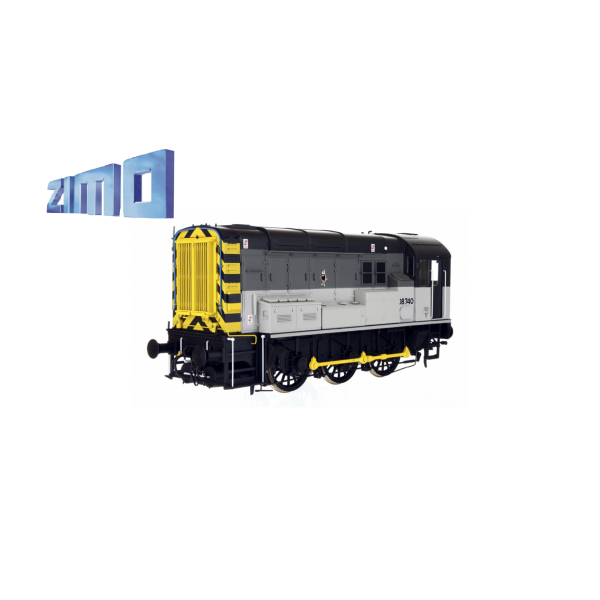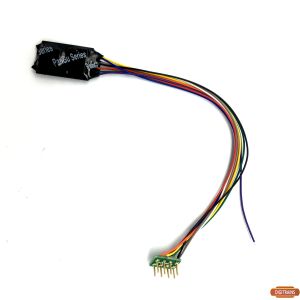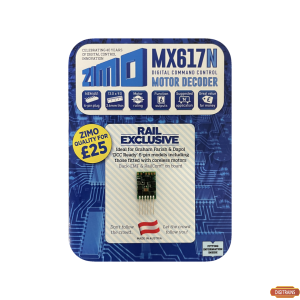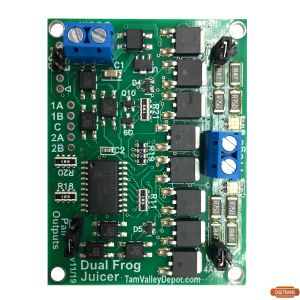ZS08D Class 08 Digidrive V21.12
Please spend a few moments to read these notes which have been produced so that you may obtain the maximum satisfaction from your new sound scheme.
The sounds should work perfectly when the decoder is fitted correctly. Individual locos may require some fine tuning that you can achieve with your DCC controller.
Engine Start Up.
The lubricating oil is pressurised with a hand operated pump prior to starting. F14 has the sound of this pump which can be played before switching on the main engine sounds.
I have separated this from the start up sounds so that you can choose to use it or not.
F 1 will crank and start the engine which will then settle down into Idle.
Driving.
It is normal for the control lever on a real Class 08 to get to ‘Notch 2’ before the engine sound changes. This is due to the gearing, the tick-over speed and the way that the generator is set up. This means that when lightly loaded a Class 08 can be moved without the engine note increasing. This sound project provides a couple of ways to simulate this.
Opening the throttle modestly will allow the model to move without engine ramping. F5 will change the exact characteristics of what happens with your style of driving.
You can, of course, also use the well proven ZIMO feature on F6 to ‘hold’ the engine sounds in Drive Idle if you find that the engine ramping response is still too sensitive for your needs.
Throttle Response Scheme.
As supplied, the decoder will produce the sounds of a Class 08 with a train on the hook.
After the start-up routine the loco will stand with the diesel engine, the Prime Mover (PM), ticking over at idle.
The sounds will respond to the throttle control in the following way:
Select speed step 1. The brakes will release, the PM will increase power to get the loco moving, and will continue until at higher speed, a further ramp up will be initiated until the final high speed running sounds begin. The precise speed steps will depend upon your model, so I suggest you make a note of the actual figures for your later use.
The sounds will spool down at similar points on deceleration.
The model can be driven in this way without ever needing to use any control other than the throttle .
For those of you who prefer something more immersive, in this custom version there are extra control features to further enhance your driving pleasure.
Coasting
No matter what actual speed your model is travelling at, or which engine note range is playing, reducing the throttle by 10 speed steps (of 128) will spool down the engine sounds to ‘Coasting’
The coasting sound will continue until you accelerate; at which point the sounds will change to those relevant to the current speed.
Alternatively, to force the engine to play idling sounds, or to avoid engine ramp up when pottering about the yard, use F6 at any time
Notch Down
During any driving sound ‘loop’, at any speed, it is possible to cause the engine power to spool down to the level immediately below. This is easily achieved by reducing the speed by one step only E.g., if the loco is playing power band 3 sounds, reducing speed with your throttle by one step will cause the sound to immediately spool down to the sound of power band 2, if in power band 1, it will spool down to idle.
Acceleration of one speed step or more will immediately ramp the sound back up to the higher power. So you can now, at any road speed, vary the engine note by reducing or adding a single speed step.
Heavy Train/Light Engine Mode Selection
The default setting is for ‘heavy train’. Inertia is high so acceleration (and deceleration) is restricted.
Activated by F5, Light Engine enables multi-function changes with one key. The switched features include reduced inertia setting to allow more rapid acceleration and engine sounds which accelerate differently.
F5 can be operated at any speed to give another way in which the engine sounds at a given road speed may be modified instantly.
The 08 has a top seed of 15mph, and the decoder has been set to a similar maximum speed. If you open the throttle gently, it is possible to drive with engine sounds only.
However, flicking the throttle wide open will cause the sound of the Traction Motors to sound before fading.
With a moving loco, try flicking the throttle open and some slow, gentle accelerations to gauge the difference, and use ‘Notch Down’ to bring another variation to the loco’s sounds
Note. This works best if you switch F5 on or off whilst the engine sounds are playing in idle. Once switched, you can leave it that way, but any further change should also be made with the engine sound again playing the idle loop. Just to be clear, the actual speed is unimportant, but the engine sound must be idling. You can achieve this in several ways as discussed above.
Dynamic Inertia
A combination of new features is included in the automatic operation of the throttle which will affect how the model responds to your control inputs.
The operation is identical in either ‘heavy’ or ‘light’ mode.
Put in simple terms, the wider you open the power controller, the quicker the engine sounds ramp up and for the first time on any decoder, the acceleration rate increases correspondingly.
What does this mean in practice?
If you use your controller’s throttle gently, with modest speed step increases, then the engine will rise and fall automatically and the model will accelerate according to the momentum setting. This is by default high for ‘heavy’ and low for ‘light’.
If however, you open the throttle rapidly, the engine will ramp up to full power and acceleration will be approximately 3 times quicker. This change in acceleration rate is variable and dependent upon throttle operation.
Live Volume Control
Provided the sound is switched on and the ‘fade’ button is not active, it is possible to change the overall volume to suit changing needs.
Engage F27 and the sound levels will gradually reduce, eventually to silence
Engage F28 and the sound levels will gradually increase, eventually to maximum.
In each case, disengage the F key when the desired level is attained. Set F27 and F28 as ‘momentary’ if your DCC controller allows you to do so.
Note: If the volume controls appear to not function, check that F19, F27 and F28 are disengaged before making a further attempt.
It’s now down to your skill and knowledge to simulate any eventuality!
Function List
|
F Key
|
Function/Sound
|
Volume
Setting CV
|
|
0
|
Lights
|
-
|
|
1
|
Sound On/Off
|
-
|
|
2
|
Toot Toot
|
517
|
|
3
|
Toot
|
520
|
|
4
|
Air release
|
523
|
|
5
|
Light Engine
|
-
|
|
6
|
EngineDrive Idle
|
-
|
|
7
|
Exhauster
|
-
|
|
8 ON
|
Buffering up
|
535
|
|
8 OFF
|
Coupling clank
|
535
|
|
9
|
Flange squeal
|
538
|
|
10
|
Shunting lights FO 1&2
|
541
|
|
11
|
Compressor
|
544
|
|
12
|
Spirax valves
|
547
|
|
13
|
Wagons taking up slack
|
550
|
|
14
|
Primer
|
553
|
|
15
|
Windscreen wipers
|
556
|
|
16
|
Door slam
|
559
|
|
17
|
Guard’s whistle
|
562
|
|
18
|
Cablight FO3
|
565
|
|
19
|
Fade All Sounds
|
-
|






